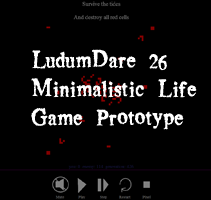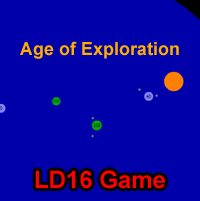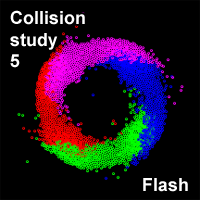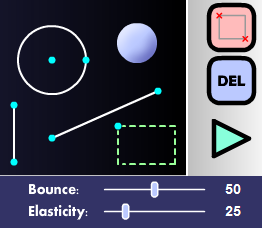HOME | DD
 wonderwhy-ER — Genetic Algorithms Homework
wonderwhy-ER — Genetic Algorithms Homework
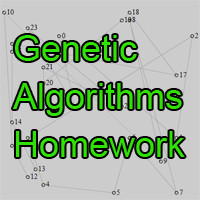
Published: 2008-04-13 15:46:00 +0000 UTC; Views: 2609; Favourites: 15; Downloads: 44
Redirect to original
Description
So in this semester I have Artificial Intelligance discipline at uni. And we have few home works there.I think that it may be interesting for some of you people so posted result of first home work.
It is about genetic algorithms.
Info on genetic algorithms
[link] - read here for better info. In short GA is one of not many ways of optimizing/searching something in field that is hard to formalize. For example if you know the function in which you look for minimal value you could use mathematics to try and solve that task. But for that you should have a very good knowledge in math and task should have appropriate mathematical representation. But in realty many tasks and problems often don’t have correct mathematical representation or representation is too hard for math to solve. So here GA helps. Thing is that principles in it allow it to find solutions in any sphere and task. Though it comes at a price of time and uncertainty. For example you can’t be 100% shore when to stop the algorithm.
Idea is simple. You usually can represent solutions as some number sequence. Then you can create criteria to judge solutions based on how good they are. Using those things you make an algorithm that creates populations of random solutions and starts an evolutionary process in which solutions compete/reproduce/mutate trying to be judged better.
Aims
So I changed the task a little so that result would be more representable.
This program receives a graph and then tries to find best mapping of graph nodes to 25x25 grid so that number of collision among edges of graph would be minimal. In some way you may say that it should untangle the graph





Explanations on interface
You can input a graph matrix in to the GraphString box and hit restart. Then algorithm will rebuild inner matrix and start looking solutions for it. String represents squired oriented incidence matrix of 0/1. Each number says if route from x node to y node exists. By default a graph of 25 nodes with that are connected in a circle is imputed.
So that means that each creature is represented by array of mapping coordinates for each node in the graph. For 3 noded triangle graphs matrix will be:
010
001
100
and creature will be:
[[0,0],[25,25],[0,25]]
You can choose one of items in generation list to see actual graph. By default after each calculation it chooses best creature to show. Sometimes you will need to click few times before it selects a creature. Thing is that algorithm runs in parallel to interface and list does not catch some of the clicks





Then there are options on parameters of algorithm:
Population size: how many creatures are created.
% of survivors: - sets % of population that is chosen are representatives that fit for reproduction. Say that with population of 100 and survivors of 50% it will chose 50 creatures and will create 50 more children from them. Children I made by choosing random pair of creatures and then creating new one with characteristics randomly taken from parents.
% of mutations: % of creatures that will be chosen for mutation.
% of effect: % of characteristics of creatures that will be randomly changed in mutation process.
Seems like that’s all. Usually somewhere in 200 generations it untangles the initial graph. Though it depends on luck.
Edit: Added start/stop button and fixed one bug.
Related content
Comments: 43

Nee. Software Engineering. Nu latviski bus kaut Pogramas istrada6ana vai kaut kas
👍: 0 ⏩: 1

Hm, jā jā , man vari netulkot 
👍: 0 ⏩: 1

Eee. KAs nozime 'ekzaktajos'?
👍: 0 ⏩: 1

Ne 
👍: 0 ⏩: 1

Получаеться exact и было в корне этого слова... Ну в принцепе компютерные науки относяться к естественым но занимаються чем ни попадя 
👍: 0 ⏩: 1

Нда ок не буду высказыватся о латвийской системе образования
👍: 0 ⏩: 1

Мне тут места не хватит
👍: 0 ⏩: 0

i couldn't say i get it..
just some dots jumping from one point to another..
understandable only for a guy who made it...
i think you could just write the algoritm down and post it in literature section..
i know that probably took alot of time and thought.. and there probably is some thought under it.. but to me those are just jumping dots that make no sence.. i don't see no evolution.. no mutation.. no nothing.. just dots..
👍: 0 ⏩: 1

Well i suppose that from level of a god we are not evolving but just some jumping dots too
I doubt that algorithm will allow you to see evolution. As i said main aim here is to untangle the graph(no line intersections) and you can see that with time it untangles it.
👍: 0 ⏩: 1

nea... i don't see anything.. just dots and lines that make no sence..
too much math.. and absolutely no aesthetics man
👍: 0 ⏩: 1

Well this thing is not about visual aesthetics
👍: 0 ⏩: 0

Pretty interesting.
Spelling error in the log.
"Mutations finihsed"
should be
"Mutations finished."
👍: 0 ⏩: 1

Hehe. Wil lcorrect it latter
👍: 0 ⏩: 0

by the way, you should tune the parameters!
intuitively, you are keeping too many of the "losers", 50% is extremely generous if looked at from the evolutionary point of view (1-legged humans allowed to survive, that's nonsense 
if i use a population of 400, 25% survivors kept, 15% of which are mutations then it reaches 1 intersection 1 like < 20 generations. with the default settings it takes forever to get there!
one thing i really enjoy about these kinda evolutionary algorithms is that you can apply a lot of very intuitive reasoning to understand the system and use good parameters for it.
👍: 0 ⏩: 1

Well actually i didn’t gave much thoughts to parameters so far. It just my guess was to find the brother where after witch fittest stop to survive and mutants and their children will take over. So setting parameters somewhere before that border would give best results. Small amount of fittest will still survive and we will have pretty large and fast changing population of challengers. But I haven't played with parameters to tune them yet. I think I will do it tomorrow before I will be handing it over to teacher.
👍: 0 ⏩: 0

btw it's artificial *intelligence, not inelegance (it's actually very elegant 
👍: 0 ⏩: 1

Ok thanks 
👍: 0 ⏩: 0

heh this makes firefox really slow, even on a multicore computer (so flash is not multithreaded!).
nice work, and interesting subject. genetic algorithms (a combination of monte carlo randomisation and fitness-based evolution) are really awesome for solving complex problems.
by the way, since you've clearly understood GAs you might be interested to compare this with the metropolis-hastings sampling i use in my rendering algorithms: [link]
👍: 0 ⏩: 1

Hmm. So some algorithm that allows to create distribution aproximations and claculate aproximate integrals? Not really shore if i know where to use such thing 
👍: 0 ⏩: 1

well, all rendering is based on integration so it forms a huge part of what i do
👍: 0 ⏩: 1

Hmm. So you use such aproximate integrals to get say fog densety in one calculation of integral?
👍: 0 ⏩: 1

for example; when you render a pixel, just evaluating the colour function once will produce ugly aliasing, so you have to integrate the product of the colour function and the reconstruction filter function. or when you're making an audio stream, a similar thing applies.
actually with my rendering system, the integrals are infinite-dimensional. have a look: [link]
👍: 0 ⏩: 1

Hmm. Seems to be large article. Thanks i will try to read it later. Seems to be interesting
👍: 0 ⏩: 0

Cool! How is this kinda process used in other AIs?
👍: 0 ⏩: 2

I suppose you mean how it could be used in games? Well usually it is not used directly in games. It just that this algorithm can solve almost anything but it’s almost a brute force that makes a lot of tries before he gets where he needs. But it can be used to teach some other systems like neural network AI for a game. Or help AI creator to get first impression on the task and see what good solutions look like and how near to good solutions look like and get ideas how he can make a solver to find those efficiently.
👍: 0 ⏩: 1

Well I figured it would be too slow for realtime applications... but yeh, is still pretty interesting!
👍: 0 ⏩: 0

you could write a pretty good travelling salesman problem solver using GAs, that's the canonical example i think
👍: 0 ⏩: 0

WOAH...
The extensive research and knowlege is astounding
👍: 0 ⏩: 1

Mm thanks 
👍: 0 ⏩: 1

^^ sweeeeet and welcome 



I think this could be used one day for extremely large populations
👍: 0 ⏩: 0

Gaaaah
GA:s are one of the most interesting things it've experimented with. Those and NN:s.
👍: 0 ⏩: 1

NN? Ouh neuron networks. Well those are close. Just smarter 
And thanks for fav
👍: 0 ⏩: 0

Wow man, you are really really good at maths. But why apply it into Flash? I mean, you'd make (much more) money doing this stuff for Playstation games or xBox games. But still, amazing work, wish I knew as much as you.
👍: 0 ⏩: 1

Well it is not as amazing as you think. Then i am not interested in consoles market. More in web 2.0 websites and browser gaming currently. Though playing with DirectX is one of things i am eager to try(well actually did few small things but don't have time and real interest now)
👍: 0 ⏩: 0

AI eh? I made an AI once... for tic-tac-toe... welll not an AI, a brutal AI. But it worked.
👍: 0 ⏩: 1

Well this thing is something like semi intelligent brute force. Depending on parameters it can find average solution pretty fast or with other parameters works slow but finds best solution(though there are no ways to determine as if we did found the best. That's one of the drawbacks of this thing).
👍: 0 ⏩: 0

this is amazing!
i wish i knew more about ai....
👍: 0 ⏩: 1

Well you always can learn
👍: 0 ⏩: 0
